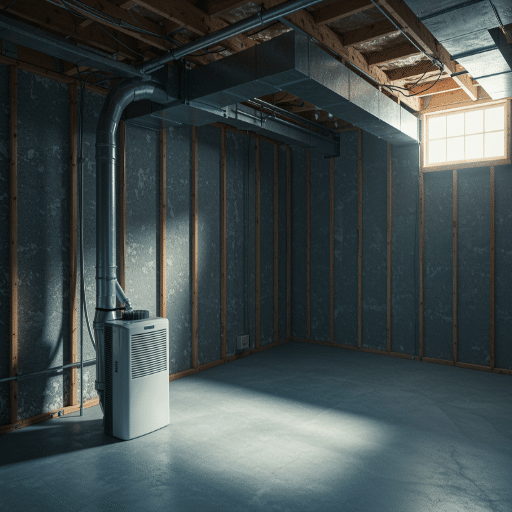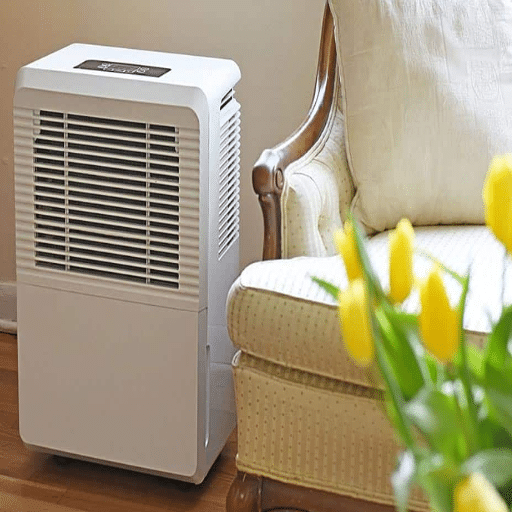The indoor air quality of a home is one aspect of health that should be emphasized, and crawl spaces are critical components that need to be focused on to achieve perfect home health. If the humidity in the crawl space gets out of control, it can lead to many problems, such as pest infestations, mold, and wood rot. Fortunately, the process of setting up crawl space dehumidifiers is easy. With the proper awareness, everybody can go through the necessary steps to set them up and improve indoor air quality. While there are several advantages of keeping your indoor air quality in check, this guide is aimed at making it easy for you to understand how to deploy crawl space dehumidifiers, how they can improve your quality of life by keeping molds, insects, and damp wood away while improving your structural integrity.
Why Do I Need a Dehumidifier in My Crawl Space?
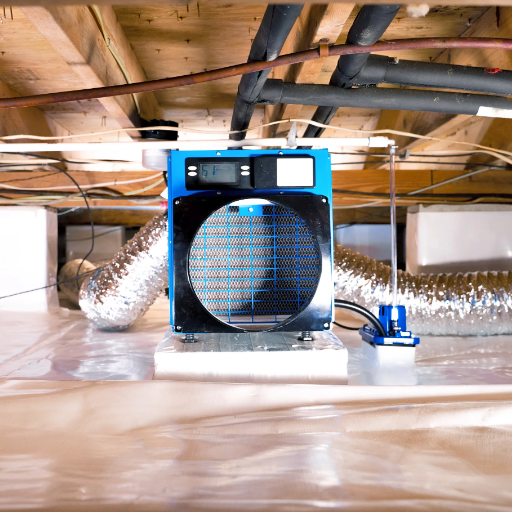
Crawl spaces are, by nature, prone to high humidity content, which can, in turn, affect the health of their inhabitants and the house’s structural integrity. The problem intensifies when the humidity is not controlled effectively; moisture and dampness lead to the growth of mold spores, which can be detrimental to wooden structures, insulation, and even the air quality within the living space, triggering respiratory illness or allergies. A dehumidifier helps maintain optimum humidity, secure the house’s structural health, and ensure your family’s well-being. This appliance ensures balance by striking an ideal moisture equilibrium, resulting in a safe, healthy, and stable environment.
Understanding Crawl Space Humidity Issues
The core cycle stems from the fact that basement humidity issues must be mitigated to maintain healthy indoor conditions. Such factors are generally a result of high humidity: condensation, groundwater seepage, or poor ventilation. These factors can primarily cause active organic growth (mold), dust rot, and pest infestations if left unregulated. I suggest employing a high-quality dehumidifier alongside other climate mitigation measures, such as a vapor barrier, to optimize moisture levels to a standard that prevents structural harm and improves air quality while ensuring stable humidity levels overall; in essence, energy costs are brought down.
The Dangers of Excess Moisture and Mold Growth
A home filled with excessive moisture is a breeding ground for mold, which can lead to devastation in terms of structural damage, as well as health complications. Among the many favorable conditions for mold reproduction, high humidity is one condition where mold grows on wooden, porous, or dry insulation materials. This can, over time, amplify the rot damage and reduce the strength of the construction of the house. In addition, these molds let go of airborne spores, worsening allergies, respiratory indifference, and even asthma in some people.
Moreover, excessive moisture can also give rise to a colony of dust mites and promote the chances of a pest invasion, both of which worsen the indoor setting. Other side ailments, such as flaky paint, bent floors, and rusted metallic fixtures, can also occur due to over-human exposure. It is crucial to respond to excessive moisture since it poses serious threats through methods such as ventilation, fixing leaks, and greater humidity.
How a Dehumidifier Improves Indoor Air Quality
Dehumidifiers are special equipment that make the levels of moisture (and dampness) in a building’s indoor air healthy. High moisture levels encourage mold, mildew, and even dust mites, known irritants that cause respiratory issues. Keeping relative humidity between 30 and 50 percent will lessen these pollutants and improve clean air standards using dehumidifiers.
In addition, dehumidifiers eliminate musty smells associated with the items placed in humid environments; thus, the spread of bacteria and fungi is kept at bay. They save structural materials and furnishings from damage, as excessive moisture can cause rotting, bending, and material breakdown. Dehumidifiers also have an air cleaning system built to improve air quality while removing allergens like dust or pet dander. All in all, the correct incorporation of dehumidifiers in a typical environment not only increases the air quality but also makes the area more comfortable and usable.
What Are the Benefits of Installing a Crawl Space Dehumidifier?

The introduction of a dehumidifier in the crawl space has numerous advantages. One is that it helps regulate moisture levels to prevent mold, mildew, and other bacteria from proliferating in damp locations. This reduces the activity of microorganisms, leading to better air quality and a healthier space for the occupants. Furthermore, it protects the building from weakening due to rot in the wood, rust formation, or any other damage that might be caused by excess moisture. Humid conditions draw a lot of insects. Hence, humidifiers can restrict insect infestation in the first place. Keeping a crawl space dry would facilitate energy conservation and improve the efficiency of HVAC appliances, which will be suitable for utility bills in the long run.
Preventing Musty Odors and Structural Damage
A well-maintained ventilation system lowers the risk of damp basements and crawl spaces, as it achieves the proper air circulation in these places. Moisture control concerning your home is the first step in eliminating odors and even occurrences of structural damage. Using vapor barriers and sealing cracks in walls or foundations helps eliminate the danger of mold and odors by keeping moisture at a minimum. An additional proactive strategy is to conduct increased diligence on the roofing and plumbing systems because even minor leaks lead to excess dampness and fungicidal rot. Regardless of such measures, owning a dehumidifier is essential as this device controls the moisture ratio and limits the chances of corrosion, wood rot, pest infestation, and molding. Gradually disinfecting and improving the air quality means further protection and integrity are provided for the home. Supplementing all the specified methods helps facilitate a healthier habitat while significantly enhancing the property’s life cycle.
Enhancing Energy Efficiency in Your Home
A dehumidifier can significantly reduce energy consumption in the home. It does this by removing excess moisture from the air, making it easier for the cooling system to do its job. Humid air can feel warmer than it is, making people use air conditioning more. A dehumidifier maintains the ideal humidity, ensuring the consumer’s needs are fulfilled and lowering energy and utility bills. Furthermore, due to modern technology, several dehumidifiers help reduce electric load, further promoting eco-friendly practices.
Protecting Your Home’s Value
The value of your house may significantly decrease if excess moisture that can stimulate mold, mildew, and even harm structural support is present. My research states that constant exposure to humidity has detrimental effects on wood forever and drywall and, over time, significantly harm a house’s foundation. In this sense, a dehumidifier helps prevent these alterations in these components by keeping the humidity under control, ensuring damages to the property are avoided; hence, the property value remains intact. Therefore, for those wanting to avoid spending a fortune on repairs, purchasing a high-quality dehumidifier would be the best solution to that dilemma.
How Do I Choose the Best Crawl Space Dehumidifier?
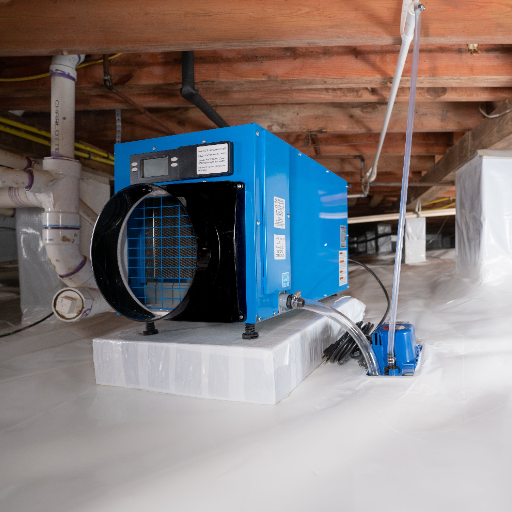
There are key factors that I thoroughly consider when selecting the right crawl space dehumidifier for my requirements. First, I check the unit’s pints per day measurement to determine whether the dehumidifier has the capacity appropriate for the size and humidity of my crawl space. A suitable power rating is another factor of utmost importance as I don’t want the electricity bill to be astronomically high while the house remains protected. Furthermore, I prefer corrosion-resistant devices with easy-to-clean filters and other types of maintenance. Finally, I check for specific characteristics that the device may have, such as automatic drainage, digital controls, and proper warranty coverage to stick with the device for a longer time.
Key Features to Look for in a Crawl Space Dehumidifier
While searching for a crawl space dehumidifier, I placed the highest importance on the moisture removal capacity so that the square footage and humidity of the crawl space can be efficiently dealt with. Since operating expenses must be kept to a minimum while avoiding unnecessary extra costs, I try to locate and purchase Energy Star-certified models. To ensure that the unit withstands harsh environments, I opt for units with coils and corrosion-resistant materials. For convenience and accuracy, automatic drainage and digital humidity control are offered along with a washable filter to replace damaged systems easily. Finally, I ensure that the unit is accompanied by warranty coverage, which protects the investment made by the customer.
Sizing Your Dehumidifier for Optimal Performance
Identifying a dehumidifier’s size is vital to controlling humidity and effectively reducing costs. To get the appropriate size, the critical metrics are the amount of feet in the area to be treated and the humidity intensity to remove. Dehumidifier capacities are generally expressed in pints of moisture extracted within 24 hours. For instance, for an area with a moderate level of dampness up to 500 square feet, a unit with 20-30 pint capacity would be enough. In cases of wanting to dehumidify larger areas between 1,000-1500 or regions of severe dampness, units that range from 50-70 pint capacity would be better able to do the job.
Even so, consider particular circumstances, such as poorly ventilated basements, areas of high humidity, or rooms with water intrusion, as they may need a higher-capacity dehumidifier. Those must be considered if ceilings are taller than eight feet or open living spaces. Calculating a unit slightly more extensive than estimated is recommended to prevent clogging and improve the conditions, which enhances the unit’s performance when conditions change and lengthens the unit’s lifespan.
What’s the Process for Installing a Dehumidifier in a Crawl Space?
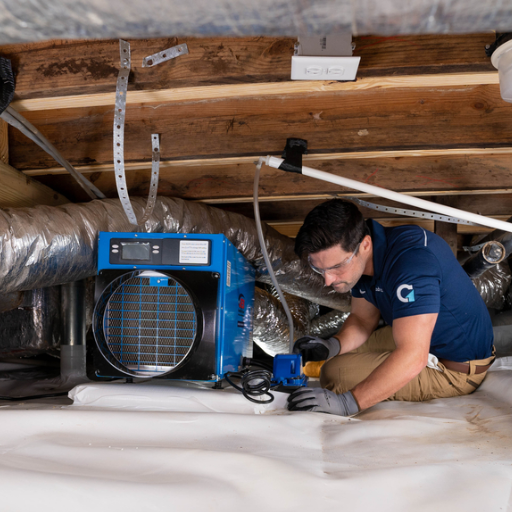
Several measures must be taken to install a dehumidifier correctly in a crawl space. First, check the crawl space for excess water or leaks and try to fix them before the installation. Second, select the best position for the dehumidifier so there is enough air circulation around it and maintenance tasks can be carried out without trouble. Stand the appliance at a sturdy height so no water can touch it. Plug the dehumidifier into an electric socket and install the drainage system, connecting it to a suitable condensation outlet or sump pump. Adjust the settings of the dehumidifier to keep the humidity in check at a desired level and check how often it runs periodically.
Preparing Your Crawl Space for Installation
To guarantee that the system put in during the repair works best over time, the crawl space must be adequately prepared; for example, it should be ensured that the dehumidifier runs appropriately. Start by checking if the crawl space has any leaks, traces of water or moisture, or any water standing: seal gaps, cracks, and vents to keep unwanted air and pests out. Place the best quality vapor barrier on the walls and flooring to restrict soil moisture. Ensure the area is clean and has proper light to work during installation and maintenance.
It is also essential to check the structural condition of the Crawl space. Support beams and the floor should not be affected by rot or severe damage. If something is applicable, energy-efficient insulation can be placed along with a vapor barrier. Last, proper drainage should be in place to prevent water from remaining near the foundation. All these procedures combined form a moderated and climate-controlled environment that ensures that the equipment used is efficient and prevents any moisture damage.
Step-by-Step Guide to Dehumidifier Installation
- Select the Right Location
First, I determine the optimal placement for the dehumidifier. Ideally, it should be in a centralized area with no obstructions to airflow, such as furniture or walls. I ensure the unit is elevated on a stable surface for basements or crawl spaces to prevent potential flooding.
- Prepare the Space
I ensure the area is clean and debris-free, with sufficient ventilation around the unit. Additionally, I confirm a nearby power outlet and verify that the drainage system is accessible for continuous operation if required.
- Install the Drainage System
If the dehumidifier supports continuous drainage, I connect the hose to the designated outlet and guide it to a floor drain, sink, or external outlet. For models requiring manual water removal, I simply position the water collection tank correctly.
- Set Up and Power On
After plugging in the dehumidifier, I configure the settings according to the ideal humidity level for the space, typically between 30% and 50%. I then turn the unit on and monitor it for several hours to ensure proper operation.
- Routine Maintenance
I periodically check the filter and clean or replace it to maintain efficiency. Additionally, I empty the water tank (if not using a continuous drainage setup) and inspect the hose for any clogs or blockages.
By following these steps, I ensure the effective installation and operation of the dehumidifier, which will maintain ideal moisture levels in the space.
Connecting Your Dehumidifier to a Drainage System
To set up my dehumidifier with the drainage system, I ensure my device can accommodate continuous drainage. I located the drained outlet, which is generally found near the water tank, and fixed a garden hose onto it. The hose should be put outdoors to a floor drain, sink, or other suitable outlet to ensure good water flow. I make sure that there are no kinks or blocks along the hose’s route. Some different types may have to be elevated so that gravity helps the dehumidifier. Otherwise, if a gravity assist option is employed, I prepare it to give me greater freedom in positioning the hoses.
Should I Encapsulate My Crawl Space Before Installing a Dehumidifier?
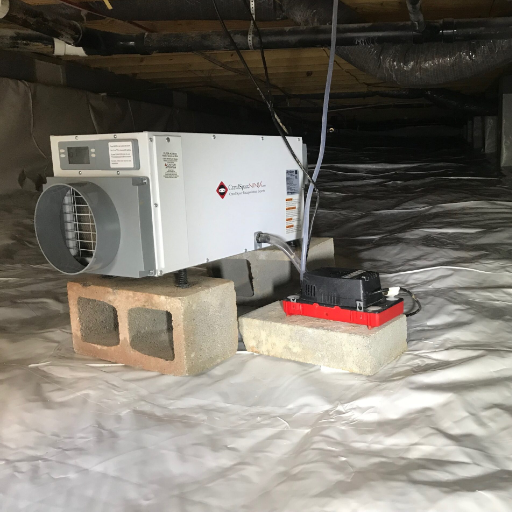
It is prudent to seal the crawl space before using a dehumidifier. Sealing allows the crawl space to be fitted with a vapor barrier to ensure no moisture comes into the area, naturally lowering the humidity and making the modifier work more efficiently. It also reduces the risk of mold, mildew, and structural damage caused by moisture accumulation. If your crawl space is well encapsulated, it provides a stable environment where the dehumidifier can work well, thus extending the unit’s life and your house’s burn foundation.
The Benefits of Crawl Space Encapsulation
Crawl space encapsulation is a complete enclosure of the area beneath a house to manage moisture disturbances. A thick vapor barrier significantly reduces groundwater and humidity leakage by sealing the area. This reduces the chances of growth, such as mold and mildew, thus improving the air quality in the house and the occupant’s health. Encapsulation also helps cut back energy costs by protecting the heating and cooling equipment, reducing the demand placed on them, and improving energy efficiency. Encapsulation also prevents water rot and rusting, causing damage to the house, keeping its structure strong. The net result is increased property value with a safe and potent long-term environment in which to reside.
Can I Install a Dehumidifier Without Encapsulation?
It is possible to fit a dehumidifier to a crawl space without encapsulation; however, this solution will likely be less efficient and effective. In the absence of encapsulation, moisture will continue to infiltrate the ground and walls, forcing the dehumidifier to work overtime to control the humidity in the space. This may result in increased amperage and inconsistent performance. However, the encapsulation technique works in synergy with a dehumidifier as it shrinks the sources of moisture, making it easier to dehumidify.
Combining Encapsulation and Dehumidification for Best Results
Perhaps encapsulation and a dehumidifier combination would be ideal for maintaining humidity in a crawl space. Encapsulation involves installing a moisture-aggressive liner on the ground and walls or, in some cases, the crawl space ceiling to keep moisture at bay. This, in turn, relieves the ground moisture or outside humid air coming in via the vents, which are prime sources of humidity. When encapsulation is integrated with a dehumidifier, the now enclosed system ensures that the system uses less energy and efficiently controls the moisture.
The humidity level inside a dehumidifier will rise because the incoming moisture is not fought. It has high running and low stability costs. However, encapsulation minimizes the problem by taking it at its source. Encapsulated areas under the building have additional benefits, such as reducing mold growth, improving air quality, and often improving home energy efficiency. These two combined are tremendous and practical protections for the house from too much moisture and its consequences.
How Do I Maintain My Crawl Space Dehumidifier?
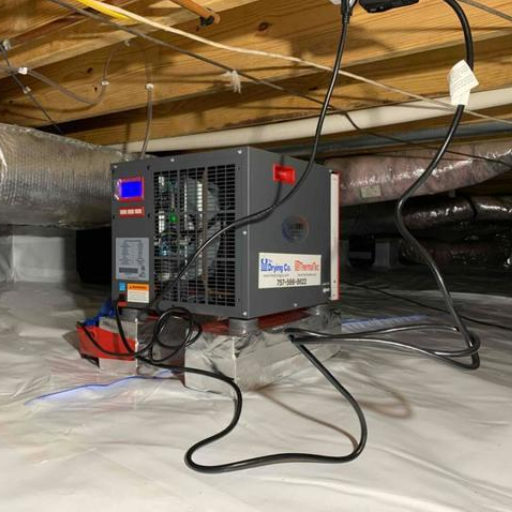
Ensuring your crawl space dehumidifier is functional means appropriately caring for it regularly. Make it a priority to clean or replace the air filter every month to not slow air flow during operation. Check for drain line blockages at your unit to avoid stagnant water and ensure appropriate drainage. Regularly cleaning dust and debris off the exterior and coils is a good way to keep things efficient, so wipe them down now and then. You also want to verify the humidity sensor and its settings are functioning correctly. Lastly, consult the manufacturer for maintenance details and get a professional if anything is beyond basic care.
Regular Maintenance Tasks for Optimal Performance
I prioritize a few tasks to optimize my crawl space dehumidifier. Regular replacement or cleaning of the air filter is essential, so I try to do that once every one to three months. The drain line is checked regularly to ensure water does not collect or get clogged up. I also make sure to clean the coils and exterior, along with dusting off any debris. To guarantee proper humidity, I check the humidity sensor now and then alongside its settings. Lastly, I ensure that I am sticking to the maintenance guidelines provided by the manufacturer before calling them for assistance regarding any repairs or performance monitoring.
Troubleshooting Common Crawl Space Dehumidifier Issues
To troubleshoot my space dehumidifier, I first look for standard problems. If the unit is unresponsive, I always begin by looking at the plug and the circuit breaker. If the device is not removing enough moisture, I check the air filter, coils, and drain line for dirt. If the humidity sensor is not working, I replace the old sensor with a new one. Most of the time, leaks or water accumulation are parts of the pair of a clogged drain or one end being detached, which I Do very promptly. Otherwise, I usually fix unusual sounds by regularly tightening the weak components or putting the unit on level ground. If they have not been solved, or the issue is more complicated, I call for the appropriate servicing, complying with the manufacturer’s instructions.
When Should I Seek Professional Help for Crawl Space Dehumidification?

A specialist should be contacted for crawl space dehumidification if basic care or troubleshooting does not resolve the concerns. For instance, when there is reasonable electricity to the unit but the dehumidifier will not start or records of repeated heating sensor breakdowns, compressor faults, or any electrical failures, one will need an expert to assist in the matter. Additionally, if any custom work on the HVAC system, extensive mold, or structural damage related to excess moisture is involved, that too warrants referrals for professional help. Likewise, suppose you are unaware of how to use the right equipment or effectively attain humidity control. In that case, professionals can assist you with various options that best suit your requirements.
Signs That Indicate the Need for Expert Assistance
Suppose there are consistent issues, such as the dehumidifier refusing to switch on despite the power supply, or other nagging problems, such as strange noises, leaking water, or error codes that are beyond my comprehension. In that case, I must call for professional help. In the case of mold visible reproduction, strong, musty smells, or even physical damage in the crawl space, professional help is essential. On the other hand, I may also seek professional help when there is uncertainty about correct sizing, installing, and maintaining the dehumidifier to enhance the humidity level in the long term.
Finding Reliable Crawl Space Dehumidifier Installation Services
To find the best crawl space dehumidifier installation, I seek out reputable and experienced companies that have worked to control moisture. To guarantee high-quality output, I look for licensing over customer reviews. Further, I lean towards providers willing to conduct a thorough assessment of my home and recommend devices. Warranties on services and products are also a necessity. Finally, I compare the prices to settle for an option that best fits my needs.
References
Frequently Asked Questions (FAQ)
Q: What are the benefits of a crawl space dehumidifier?
A: A crawl space dehumidifier offers numerous benefits, including reducing moisture levels, preventing mold growth, improving indoor air quality, and protecting your home’s structural integrity. It helps keep your crawl space dry, essential for maintaining a healthy home environment and preventing issues like wood rot and pest infestations.
Q: How do I know if my crawl space needs a dehumidifier?
A: Signs that your crawl space needs a dehumidifier include musty odors, visible mold growth, condensation on surfaces, wood rot, or high humidity levels. If you notice any of these issues or your home’s dampness, your crawl space could likely benefit from a dehumidifier installation.
Q: Can I install a dehumidifier in my crawl space without encapsulation?
A: While it’s possible to install a dehumidifier in a crawl space without encapsulation, it’s generally not recommended. Encapsulation helps create a sealed environment, making the dehumidifier more effective. However, if encapsulation isn’t feasible, using a dehumidifier can still help control moisture levels to some extent.
Q: What is the crawl space dehumidifier installation process like?
A: The installation typically involves assessing the crawl space’s size and moisture levels, choosing the right dehumidifier, placing it in an optimal location, setting up proper drainage (often connected to a sump pump), and ensuring adequate ventilation. Professional installers will seal any obvious moisture entry points and may recommend additional crawl space repair measures if needed.
Q: How do I choose the right dehumidifier for my crawl space?
A: Selecting the right dehumidifier depends on your crawl space’s size, moisture levels, and specific needs. Consider the unit’s capacity (measured in pints per day), energy efficiency, and durability. It’s often best to consult a professional who can assess your crawl space and recommend the most suitable option, such as an AquaStop™ crawl space air system.
Q: How often should I maintain my crawl space dehumidifier?
A: Regular maintenance is crucial for optimal performance. Generally, you should check your dehumidifier monthly, clean or replace filters as needed, and ensure proper drainage. Annual professional inspections are recommended to assess the overall condition of your crawl space and the dehumidifier’s effectiveness in controlling moisture.
Q: Can a crawl space dehumidifier help with other home issues?
A: A dehumidifier in your crawl space can help with various home issues. Controlling moisture can reduce allergies and asthma symptoms, lower energy costs by improving HVAC efficiency, prevent pest infestations and even help preserve stored items. Addressing crawl space moisture also contributes to overall home health and comfort.
Q: Where can I find a crawl space dehumidifier installation near me?
A: To find crawl space dehumidifier installation services near you, search for local crawl space repair or waterproofing companies online. Look for businesses with good reviews and experience in crawl space moisture control. Many reputable companies offer free inspections and quotes, allowing you to compare options and choose the best service.


